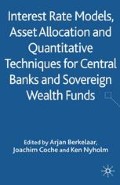Abstract
We study the problem of diversifying a given initial capital over a finite number of investment funds that follow different trading strategies. The investment funds operate in a market where a finite number of underlying assets may be traded over a finite discrete time. Our goal is to find a diversification that is optimal in terms of a given convex risk measure (see e.g. Föllmer and Schied 2004, Chapter 4). We formulate an optimization problem in which a portfolio manager is faced with uncertain asset returns as well as liabilities.
Access this chapter
Tax calculation will be finalised at checkout
Purchases are for personal use only
Preview
Unable to display preview. Download preview PDF.
Bibliography
Black, F. and Jones, R. (1987) ‘Simplifying Portfolio Insurance’. Journal of Portfolio Management, 14(1): 48–51.
Black, F. and Perold, A. F. (1992) ‘Theory of Constant Proportion Portfolio Insurance’. Journal of Economic Dynamics and Control, 16: 403–426.
Bodie, Z. and Treussard, J. (2007) ‘Making Investment Choices as Simple as Possible, but not Simpler’. Financial Analysis Journal, 63(3): 42–47.
Engle, R.F. and Granger, C. W. J. (1987) ‘Co-integration and Error Correction: Representation, Estimation, and Testing’. Econometrica, 55(2): 251–276.
Föllmer, H. and Schied, A. (2004) ‘An Introduction in Discrete Time’. Stochastic Finance, Volume 27 of de Gruyter Studies in Mathematics. Walter de Gruyter & Co., Berlin, extended edition.
Koivu, M. and Pennanen, T. (to appear) ‘Galerkin Methods in Dynamic Stochastic Programming’. Optimization.
Pennanen, T. and Koivu, M. (2005) ‘Epi-convergent Discretizations of Stochastic Programs via Integration Quadratures’. Journal of Numerical Mathematics, 100(1): 141–163.
Perold, A.F. and Sharpe, W. F. (1995) ‘Dynamic Strategies for Asset Allocation’. Financial Analysis Journal, 51(1): 149–160.
Rockafellar, R.T. (2007) ‘Coherent Approaches to Risk in Optimization under Uncertainty’. Tutorials in Operations Research INFORMS 2007, 38–61.
Rockafellar, R.T. and Uryasev, S. P. (2000) ‘Optimization of Conditional Value-at-Risk’. Journal of Risk, 2: 21–42.
Sharpe, W.F. (2007) ‘Expected Utility Asset Allocation’. Financial Analysis Journal, 63(5): 18–30.
Editor information
Editors and Affiliations
Copyright information
© 2010 Palgrave Macmillan, a division of Macmillan Publishers Limited
About this chapter
Cite this chapter
Hilli, P., Koivu, M., Pennanen, T. (2010). Optimal Construction of a Fund of Funds. In: Berkelaar, A.B., Coche, J., Nyholm, K. (eds) Interest Rate Models, Asset Allocation and Quantitative Techniques for Central Banks and Sovereign Wealth Funds. Palgrave Macmillan, London. https://doi.org/10.1057/9780230251298_11
Download citation
DOI: https://doi.org/10.1057/9780230251298_11
Publisher Name: Palgrave Macmillan, London
Print ISBN: 978-1-349-31641-0
Online ISBN: 978-0-230-25129-8
eBook Packages: Palgrave Economics & Finance CollectionEconomics and Finance (R0)

